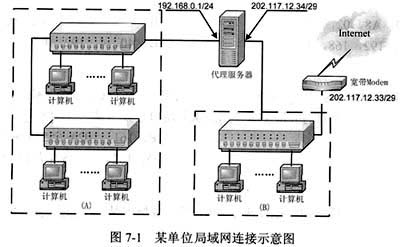某公司局域网通过ISP提供的宽带线路与Internet相连,其网络连接方式及相关的网络参数如图7-1所示。其中,ISP分配给该公司的公网IP地址为202.117.12.32/29。

该公司有一台需对外发布公共信息的Web服务器,则其部署的位置以及相应的网络改进措施是______。
由于受一些条件因素变化的影响,电信部门分配给该公司的公网IP地址变更为102.117.12.32/30,则规划师对图7-1所示的网络连接最可能采取的应对措施是______。
A.无需改动图7-1所示的网络连接方案,只需重新调整代理服务器的NAT配置参数
B.将代理服务器与宽带Modem直接连接,去掉区域(B)
C.在宽带Modem的下连端口串入一台新增的代理服务器(或数据交换专用服务器)
D.去掉代理服务器,将区域(A)、(B)合并为同一区域并使用地址块10.X.X.X重新规划该区域的IP地址
参考答案:B
解析: 区域(B)所接入的计算机将使用公网IP地址直接访问Internet,该区域计算机所分配的IP地址应与代理服务器外网卡的IP地址同处一个网段。同时考虑到ISP分配的公网IP地址为202.117.12.32/29,其中“/29”是子网掩码的缩写形式,表示子网掩码的前29位为“1”,其对应的点分十进制数是255.255.255.248。该网段共有232-29-2=23-2=6个可用的IP地址(202.117.12.33~202.117.12.38),扣除已作为该网段网关地址的1个IP地址(202.117.12.33),再扣除已分配给代理服务器外网卡的IP地址(202.117.12.34),那么区域(B)计算机可用的IP地址范围是202.117.12.35~202.117.12.38,子网掩码是255.255.255.248,默认网关地址是202.117.12.33。
由于IP地址为192.168.0.35的计算机属于区域(A),需要通过代理服务器连接到Internet,因此其发送到Internet上的IP数据包的源IP地址为202.117.12.34。IP地址为202.117.12.35的计算机属于区域(B),其发送到Internet上的IP数据包的源IP地址没有经过地址变换,以202.117.12.35源IP地址的形式在Internet中出现。
如果将对外发布公共信息的Web服务器部署在图7-l的区域(B),则该单位的客户、潜在用户和外部访问者无需通过该单位的内网就可以直接获得他们所需要的关于公司的一些信息。同时建议该单位通过相关技术,将区域(B)部署成防火墙中的DMZ区(即非军事区),允许外网用户有限度地使用其中的资源,又可保障该Web服务器的安全。
如果电信部门分配的公网IP地址为202.117.12.32/30,其中“/30”表示子网掩码的前30位为“1”,其对应的点分十进制数是255.255.255.252,该网段共有232-30-2=22-2=2个可用的IP地址(202.117.12.33、202.117.12.34),而IP地址202.117.12.33已作为连接电信部门的网关地址,IP地址202.117.12.34已作为代理服务器外网卡的IP地址,已没有空闲的公网IP地址可用,则图7-1的区域(B)中不能再接入使用公网IP地址直接访问Internet的计算机。因此需将代理服务器与宽带Modem直接连接,即将区域(B)去掉,使代理服务器与Internet属于点对点的连接方式。
